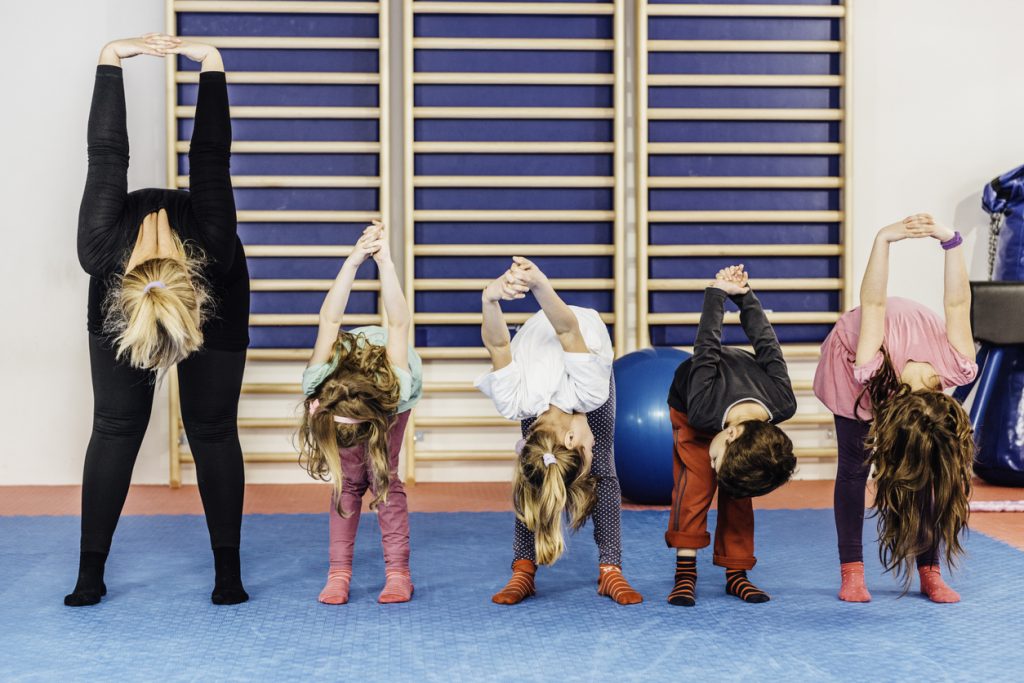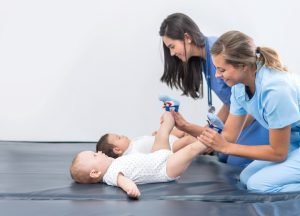We all know how hard it is to stay motivated with our rehab, and it can be even harder to keep our children motivated through the physiotherapy process.
Kensington Physio’s Senior physiotherapist Annabel H, who has a particular interest in physiotherapy for children and adolescents, gives us some tips for different age ranges!
What’s the best way to keep a child motivated with their physio?
It’s very dependent upon the age of child or adolescent as to the best strategy to keep them happy and keen about physiotherapy, so I have split my suggestions into some broad age groups. However, strategies certain age groups may work for a wider range of ages, and are also dependent on the patient’s developmental level, so feel free to use whichever techniques work best!
Infant (0-2 years)
At this age, children need to be encouraged to achieve the movement through play or attention. As a baby, they are not able to yet follow verbal commands, although by the age of two, they should respond to simple commands. The most important thing is to keep physio sessions very short so that they remain fun, but then try to do little bits often throughout the day.
Here are a few examples:
If we want bub to turn their head, we might wave a toy in their field of vision and then slowly move it to one side so that they follow it around. Sound cues such as a rattle can work well too, even moving your face in and out of their field of vision can work well too.
If you are having trouble with your baby tolerating tummy time, lying them on your chest and having mum or dad to look at can help them learn to love it! You may both end up having a little nap though…
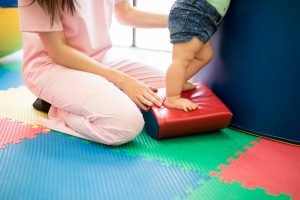
With babies, we often need to do completely passive exercise as well as they can’t follow instructions yet. These sessions need to be short and enjoyable for bub, so warm up your vocal chords as singing is a great way to keep them happy and distracted whilst you do their stretches. These passive stretches get harder to complete as they get more mobile, because they get bored more quickly being in the same spot.
Getting your toddler to play whilst standing on a wedge for example can help with stretching their calves and improving their balance. Even just encouraging them to stand with straight legs and heels down whilst playing at a table can help to stretch the calves and assist with issues such as toe walking.
Pre-school (3-5 years)

At this age, children can follow commands, but still don’t really have the insight about the benefits of the exercises they are performing to assist them in managing their injury or condition. Exercises still need to be in the context of play as much as possible, with perhaps a couple of more targeted exercises which are dispersed amongst the ‘play time’, but without the child necessarily identifying them as physio exercises.
The novelty of a theraband may last long enough for them to do a few more targeted and specific exercises, but don’t expect more than one or two sets of 1-2 exercises!
This exercise may be used to improve balance, coordination and/or leg strength. You could also use coloured tiles or tape on the floor for them to use as a target to jump to. Even a line of tape along the floor or following along a floorboard without falling off can be a good balance exercise.
Using play equipment can be a great way for kids to do their physio without noticing they are ‘doing’ their physio, in this example walking up a ramp with their heels down can stretch their calves and help with toe walking.
Prep school (6-12 years)
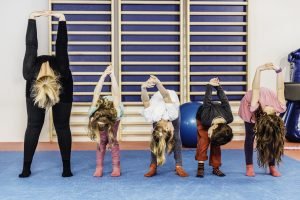
Children of this age have now all started school, so are used to following instructions and participating in more formal and structured activities. This is the time that children can be much more actively involved in their rehabilitation process (dependent on mental and emotional development), and will do more ‘adult’ type exercises which we would normally associate with physio. However, as we know, these exercises can get quite tedious, so it is important to still keep exercise sessions as short and fun as possible to avoid a battle to get them done. Sometimes something as simple as a sticker chart can be a good motivator!
Sometimes joining a group class can be fun and keep kids motivated. It is also a great way for them to see that there are other kids doing physio too! Also, if you are having difficulty with your child adhering to a specific home program, sometimes your physio may be able to suggest another mainstream form of exercise such as gymnastics or martial arts which may be a good option for your child to attain the skills they need.
Doing exercises with mum and dad can be fun for kids, particularly if the exercises are seen as ‘I’m doing grown up exercises with mummy and daddy’, rather than ‘mummy and daddy are doing my childish exercises with me’
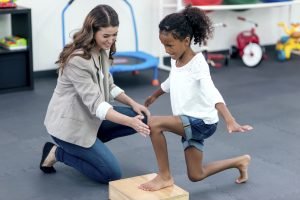
By 8 years of age, most children will be able to perform more traditional physiotherapy exercises in a structured environment. However, encouragement such as a sticker chart at home can be helpful with achieving compliance with the home program.
Allowing a period of free play (obviously safely and supervised) with the equipment, can help the children feel more at home and confident and allow your therapist to see them in action.
High School (13-18 years)
Whilst this age group should not really be lumped in with ‘children’, they are an age group that often requires physiotherapy, so I wanted to briefly mention them.
When presenting for physiotherapy for the first time at this age, patients will have generally sustained a specific (often sport related) injury. This means that they are fairly motivated as they want to return to activity as soon as possible. However, sometimes it will be difficult to get them to commit to a longer term program if they are recovering from surgery or have a condition which requires prolonged physio.
By this time, teenagers and adolescents will have complete insight into actions and consequences, so they can (and should be) treated like adults in that the injury should be explained to them and the reasoning behind each step taken disclosed. By being given ownership of their program and care plan, they will feel empowered to create their own recovery and if they understand the reason they are being given boundaries (e.g. it’s to protect the healing ligament), they are less likely to overstep them.
However, it is still very important to involve their parents as well, to ensure commitment to the program. It is also important to be clear about goals and timeframes from the outset, as they will lose trust and motivation very quickly if they feel they are not progressing as they should, or are not being told the full story.
Book an assessment with us
As you can see, a slightly different approach needs to be taken for children of different age groups. If you are concerned about any area of your child’s movement or they are getting any pain with activity, please do not hesitate to contact us for an assessment.
Author: Annabel Hawker

